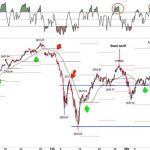Stocks Don’t Like Gradual Tax Cut
Stocks fell slightly on Monday on the prospect that corporate tax rates could be lowered gradually. The small caps are affected the most by this legislation because they have the highest percentage of domestic earnings. This caused the Russell 2000 to fall 1.15%. We are in the lead up period prior to the announcement of the plan, so there will be many reports of various potential policies. Sometimes the media is used as a leverage point to make changes to the bill. For example, the border adjusted tax was eliminated after it was floated in the media because retailers lobbied that it would hurt them unfairly. Therefore, it’s important to take every report with a grain of salt. The latest report cites the tax writing committee which is discussing cutting the corporate tax rate to 20% by 2022.
When looking at the cost of tax cuts over 10 years, having less tax cuts over the first few years, helps bridge the funding gap. I don’t think this is bad news because it simultaneously lowers the benefits corporations will get and increases the chances that it will pass. This makes it a wash. The concept that a plan with goodies for everyone can pass is farcical. Tough decisions need to be made to bridge the funding gap. The tough decisions being made, which have previously been discussed, means progress is being made. Currently, the PredictIt odds show a 32% chance of a corporate tax cut in 2017 (up 8%) and a 26% chance individual taxes will be cut in 2017 (down 1%). I think passing a corporate tax cut without an individual tax cut, makes the GOP look bad politically, but it makes sense the phase in of the corporate tax cut would increase the odds of it passing. It would probably be politically impossible and inefficient to phase in individual tax cuts. The point is to simplify the tax code for individuals. I can’t think of many things more complicated than rates constantly changing.
Q3 Earnings
The earnings growth is now expected to be 4.7% in Q3 which is the lowest growth rate since 2.8% in Q3 2016 according to FactSet. The chart below illustrates the weakest industries. This weakness isn’t like the earnings recession because it’s being led by the insurance industry which was hurt by the hurricanes which are non-recurring events. If you exclude the insurance industry, earnings growth would be 7.5%. In the beginning of the quarter, I asked the question why earnings estimates fell so much in Q3. As you can see, the main reason for the weakness was the weather. Also, keep in mind that the earnings results are blended meaning estimates and actual results are included. When the earnings season is over, the growth rate will improve by a couple of points making it look like a normal earnings quarter when you exclude insurance companies.













Leave A Comment